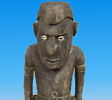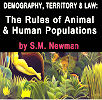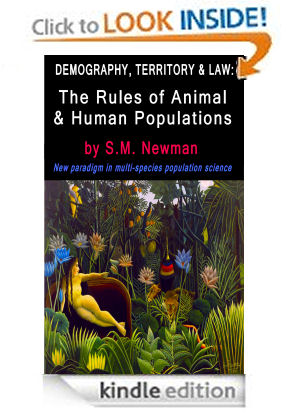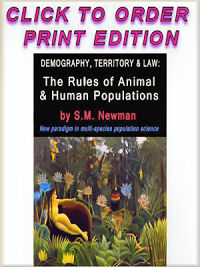Ancestor worship and why we should revive it
 Ancestor worship, or the belief that your ancestors look after you and live among you, seems like a good kind of belief to me, when I consider the anonymity and general invisibility of the old and the dead in modern Australian society. Although money can sometimes buy you a big send-off, like the truly grandiose one for a big sports-mogul the other day, it may inspire resentment: "Seems kind of unfair," commented an elderly friend, "When you and I shall be forgotten, absent any fanfare."
Ancestor worship, or the belief that your ancestors look after you and live among you, seems like a good kind of belief to me, when I consider the anonymity and general invisibility of the old and the dead in modern Australian society. Although money can sometimes buy you a big send-off, like the truly grandiose one for a big sports-mogul the other day, it may inspire resentment: "Seems kind of unfair," commented an elderly friend, "When you and I shall be forgotten, absent any fanfare."
Ancestor worship in a small endogamous and sedentary (viscous) population keeps the dead alive and recycling as the living. It makes everyone important members of the tribe, never to be forgotten. Everyone knows each other and the dead cannot have been much different, so you feel as if you know them. They are a part of you. What the lives of ancestors many generations back may lose in detail, they gain in heroic stature and magic powers. They have their own spirit realm where they may be reached for consultation, using various rituals. As they grow up, individuals look in themselves for inherited skills and heroic tendencies that they know to exist in the tribe.
In 'modern' western settler states tribes are too dispersed for people to be able to remember their ancestors properly. Their direct experience of ancestors is usually limited to a couple of generations, not necessarily complete. The problem is that people in such societies no longer live in the same place as their ancestors, experiencing the same trees, animals, and sights of the same local environment, and the food and water it produces. They now live in recently constructed houses and apartments that have obliterated all the nature around them and all trace of the people who lived there, including their burial places. Our existences seem as fragile as the photographs and documents we retrieve from family-tree searches. Deceased blood relatives seem rootless in an abstract history full of strangers. The need to search for one's ancestral tribe remains strong nonetheless, as we see from people having DNA tests to try to get a vague idea of their origins, but all they get back is links to a hotchpotch of anonymous lost souls.
You can understand why people get so upset when a tree is cut down or an old building destroyed, when the park is paved over, or the bush where they grew up is destroyed, along with its wildlife. It's because we have deep instincts for roots, relatives, and for an intimate long-term tribal relationship with our local environment, which our lives once depended on and which they may again depend on.
Conveniently for capitalism, the yearning for one's lost tribe is easily displaced onto brand names, football teams, NGOs, employers, schools, political parties, temples, aged-care, and other institutions. Many such false tribes practice conditional acceptance, based on whether you are paid-up or not. Even cemeteries now dig you up after a few decades, if you don't pay their ransom. More and more of us go up in smoke these days, contributing to climate change and robbing the earth of our nutrients.
There is an old proverb that says that you can break a stick, but a bundle of sticks if very hard to break. Just imagine for a moment if we married second and more distant cousins, and inherited our land from each other - like the Rothchilds or the Windsors.[1] Some of us would not marry because we would run out of cousins, but we would all have a place. We would share our illustrious and villainous ancestors; the history of how they won and defended our land would inspire us. And when the developers came to build on our cemetery, we would fight them to the death. The very wealthy know this and found dynasties. By marrying their relations, they preserve land, assets and power within family and clan.
Australian society is however, increasingly disorganised by routines of lengthy commutes, and property and custody struggles following divorce. Families are geographically separated due to global employment opportunities and social drift. Suburban infill and housing insecurity resulting from large influxes into cities churn neighbourhoods so that we no longer have old neighbours and a sense of community. The cliche that "we are all migrants" has some truth to it, but in the ways mentioned, we are prevented from truly making Australia our home in the long term sense that would allow us a connection to our ancestors as fellow inhabitants of this place.
See also "Overpopulation: Endogamy,Exogamy and fertility opportunity theory."
NOTES
[1]On the Rothschild strategy for consolidating wealth by staying as a tight-knit clan: https://www.academia.edu/39626199/The_House_of_Rothschild.
The below is from another fascinating article by Adam Kuper, "Incest, cousin marriage, and the origin of the human sciences in nineteenth- century England, Past and Present, 2002: https://www.academia.edu/38993793/INCEST_COUSIN_MARRIAGE_AND_THE_ORIGIN_OF_THE_HUMAN_SCIENCES_IN_NINETEENTH-CENTURY_ENGLAND.
[...] Queen Victoria, a model of propriety, married her first cousin, Albert, her mother's brother's son. This was and remains a Hanoverian tradition. George I had married his father's brother's daughter, and George IV his father's sister's daughter.
George V and Elizabeth II carried on this tradition, both marrying second cousins. The tradition may be traced back to the Stuarts.
The parents of James I were first cousins, children of a half-sister and half-brother.25)
Love and marriage between cousins became a regular topic of novels in nineteenth-century England. In Mansfield Park (1814), Fanny married Edmund, her mother's sister's son. In Persuasion (1817), Charles Hayter similarly married his mother's sister's daughter, Henrietta Musgrave. In the same novel, Elizabeth Elliot dreams of a marriage with her cousin and her father's heir, William Elliot (apparently her second cousin in the male line), and he later woos her sister Anne. Any objections to these relationships had to do with such extraneous factors as the difference in status between Fanny and Edmund or Henrietta and Charles. There were similar marriages within Jane Austen's own family. Jane's brother Henry married his widowed cousin, Eliza de Feuillide, after Eliza had rejected his brother James.27 (Another of Jane Austen's brothers, Charles, married his dead wife's sister in 1820, albeit 'to general disapproval'.)Cousin marriages continued to feature regularly in English novels and plays to the end of the nineteenth century, without being represented as strange or problematic. As late as 1895, The Importance of Being Ernest ends with the happy discovery that Ernest and Gwendolen are cousins. His mother was not a handbag, or Miss Prism, but Lady Bracknell's sister. Since they were the children of two sisters, Lady Bracknell could have no objection to their marriage.
What the anthropologists were later to term sister exchange was also an established royal tradition. The Hanoverians were famous for it. In the nineteenth century it became a familiar practice in middle-class circles. The marriage of Charles Darwin to Emma Wedgwood was a case in point. Not only were they first cousins, but since Emma's elder brother, Josiah Wedgwood III, had married Charles's elder sister, Caroline, the two men were also exchanging sisters. The combination of marriage to first cousins with a propensity to sister exchange (or with the marriage of two brothers to a pair of sisters) meant that it was not uncommon in the next generation for double first cousins to marry. Darwin's father-in-law Josiah Wedgwood II and his brother John Wedgwood (themselves children of third cousins)married two sisters. In the next generation, John's daughter, Jessie, married Josiah's son, Henry Allen Wedgwood. She was his father's brother's daughter and also his mother's sister's daughter.
[...] Recent studies show that the incidence of first-cousin marriage was significantly higher in some British or British-derived population during the nineteenth century than George Darwin's statistic suggested. Men of Boston Brahmin families had a remarkably high level of close kin (mostly first-cousin) marriage from 1680 to 1859, averaging around 25 per cent, but climbing to 66.6 per cent in the middle of the eighteenth century. Sibling exchange was also common." Close-kin marriage was by no measure restricted to the elite. In the first half of the nineteenth century, 20 per cent of marriages among Protestant Northern Irish immgrants to the Midwest were with first cousins. Highland Scot migrants to New Zealand were also strikingly endogamous. What Maureen Molloy calls 'kin group endogamy' reached 70 per cent in some areas. Sibling exchanges were frequent, and 'it is quite common to find three siblings marrying two sibling cousins and a third cousin or cousin's cousin'. Molloy found genealogic evidence to show that this pattern preceded emigration, and argued that it was perhaps related to the imposition of British rule and population resettlement."

 Did fossil fuel cause capitalism or did capitalism cause the creation of the technology to use fossil fuel for industrial processes? Did population start to grow in Britain before or after industrial capitalism? Why did the industrial revolution begin in Britain? Were there any precedents? Beginning before Roman Britain, this work of evolutionary sociology also looks at how Doggerland, sea-level changes accompanying ice-ages and global warming, forestation changes, malaria and plagues may have affected population movement, along with kinship rules, inheritance laws, and access to distant and denser communities through new modes of transport. Then, departing from Roman Britain, the book examines changes to the political system, fuels, technology and demography during the Reformation, the Restoration, the Dutch capitalist revolution, and the Trade Wars, to the eve of the French Revolution, which is the subject of the next volume. Hint: The cover on this book is like a treasure map and contains the major elements of the final theory.
Did fossil fuel cause capitalism or did capitalism cause the creation of the technology to use fossil fuel for industrial processes? Did population start to grow in Britain before or after industrial capitalism? Why did the industrial revolution begin in Britain? Were there any precedents? Beginning before Roman Britain, this work of evolutionary sociology also looks at how Doggerland, sea-level changes accompanying ice-ages and global warming, forestation changes, malaria and plagues may have affected population movement, along with kinship rules, inheritance laws, and access to distant and denser communities through new modes of transport. Then, departing from Roman Britain, the book examines changes to the political system, fuels, technology and demography during the Reformation, the Restoration, the Dutch capitalist revolution, and the Trade Wars, to the eve of the French Revolution, which is the subject of the next volume. Hint: The cover on this book is like a treasure map and contains the major elements of the final theory.  Available in kindle and in print. This book was inspired by 'collapse theory' to look at stable systems in animal and human populations and to define their principles. It introduces a new biological theory of human population numbers, land-ownership and property inheritance. As such it is also about the economic 'fundamentals' of civilisation. Using the concepts of endogamy and exogamy the author points out the persistent importance in world affairs of clans and tribes - be they royal dynasties, family corporations or nation states. Newman shows that in Britain, the United States, Canada and Australia, power, wealth and land are accumulated in fewer and fewer hands by systems that promote disorganisation and displacement of the masses. In contrast, other modern systems in continental Europe and elsewhere, enable families and clans to much better defend citizens' rights and to democratically conserve local land, resources and environment, effectively resisting population growth. This information is not available elsewhere and needs to be widely known. The book is the first of four volumes. SECOND VOLUME NOW OUT:
Available in kindle and in print. This book was inspired by 'collapse theory' to look at stable systems in animal and human populations and to define their principles. It introduces a new biological theory of human population numbers, land-ownership and property inheritance. As such it is also about the economic 'fundamentals' of civilisation. Using the concepts of endogamy and exogamy the author points out the persistent importance in world affairs of clans and tribes - be they royal dynasties, family corporations or nation states. Newman shows that in Britain, the United States, Canada and Australia, power, wealth and land are accumulated in fewer and fewer hands by systems that promote disorganisation and displacement of the masses. In contrast, other modern systems in continental Europe and elsewhere, enable families and clans to much better defend citizens' rights and to democratically conserve local land, resources and environment, effectively resisting population growth. This information is not available elsewhere and needs to be widely known. The book is the first of four volumes. SECOND VOLUME NOW OUT: 

Recent comments